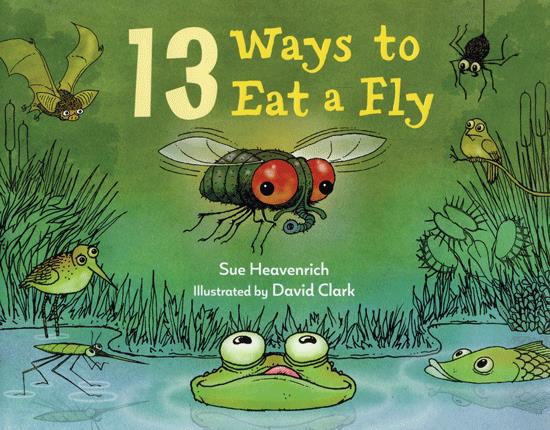| 13 ways to eat a fly Author: Heavenrich, Sue | ||
| Price: $21.88 | ||
Summary:
Thirteen flies become tasty snacks in this clever reverse counting book about predators and prey. Science meets subtraction as a swarm of flies buzzes along, losing one member to each predator along the way. Includes a guide to eating bugs, complete with nutritional information for a single serving of flies.
| Illustrator: | Clark, David |
| Accelerated Reader Information: Interest Level: LG Reading Level: 4.50 Points: .5 Quiz: 515761 |
Reviews:
School Library Journal (00/02/21)
Booklist (+) (01/01/21)
Full Text Reviews:
Booklist - 01/01/2021 *Starred Review* Guess who’s coming to dinner? Well stocked with easy-to-digest facts, from nature notes (“The frog closes its eyes and swallows, using its eyeballs to push the fly down its throat”) to the taxonomic names of the 13 different kinds of flies that Clark renders with distinguishing details (and deservedly anxious expressions) in his cartoon illustrations, this disquisition on flies as food will draw swarms of young readers. Following a countdown entrée in which the said baker’s dozen are, one by one, gobbled up by predators ranging from birds, bats, and a fly-eating fungus to an unwary skateboarder (gross but, claims Heavenrich, “harmless”), subsequent courses dish up observations on the insect’s importance as a food source, its real potential as a food additive, its nutritional content (with a table modeled after the one printed on cereal boxes), and a labeled chart of fly body parts, from the “soft and chewy” Abdomen to Antennae (“high in fiber”). Budding STEM-winders especially will relish meaty closing lists of print and web resources. Amplify the buzz by pairing this biological bounty with Brigit Heos’ introduction to another segment of the life cycle, What to Expect When You’re Expecting Larvae (2011), illustrated by Stéphane Jorisch. - Copyright 2021 Booklist.
School Library Journal - 02/01/2021 K-Gr 3—Thirteen short, rhyming answers are given to this question: How do birds, fish, mammals, and insects capture and eat flies? Some of these feeding methods are described as "zapped," "wrapped," and "underground." Each of these tactics is explained in a descriptive paragraph of two or three sentences that centers on a specific animal and how it eats flies. For example, a garden spider captures a fly in its web, injects its prey with poison, and then wraps it in silk so that it resembles a burrito. Each paragraph is accompanied by a large illustration or two. These colorful illustrations are clear, but often humorously exaggerated. The text concludes that flies are a major food source for many animals. Educators could use this book for multiple lessons. The rhyming "ways" to eat a fly could be adopted for choral reading, with some of the factual information also included. Children could discuss how different animals capture and eat flies as food. VERDICT A lighthearted nonfiction picture book that could easily be used with young children in different ways.—Myra Zarnowski, City Univ. of New York - Copyright 2021 Publishers Weekly, Library Journal and/or School Library Journal used with permission.



